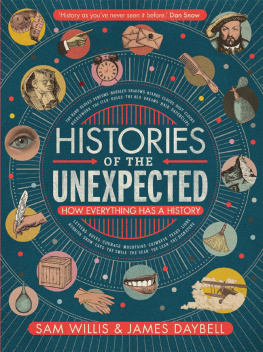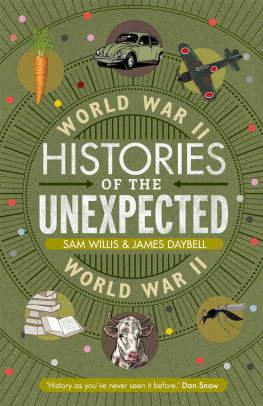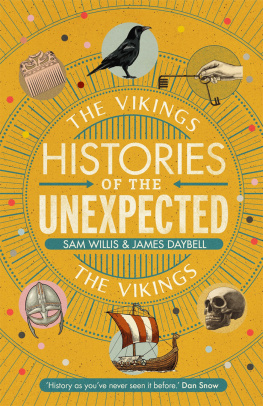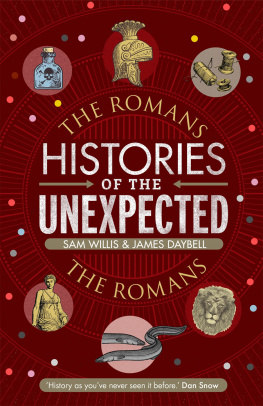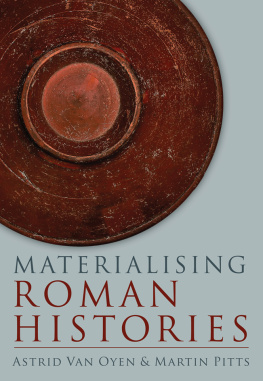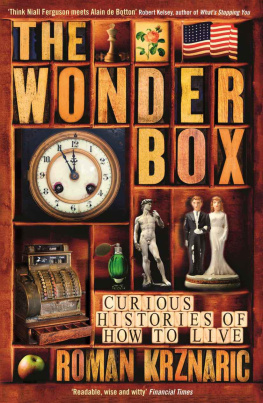
First published in hardback in Great Britain in 2018
by Atlantic Books, an imprint of Atlantic Books Ltd.
Copyright Sam Willis & James Daybell, 2018
The moral right of Sam Willis and James Daybell to be identified as the authors of this work has been asserted by them in accordance with the Copyright, Designs and Patents Act of 1988.
All rights reserved. No part of this publication may be reproduced, stored in a retrieval system, or transmitted in any form or by any means, electronic, mechanical, photocopying, recording, or otherwise, without the prior permission of both the copyright owner and the above publisher of this book.
1 2 3 4 5 6 7 8 9
A CIP catalogue record for this book is available from the British Library.
Hardback ISBN: 978-1-78649-412-2
E-book ISBN: 978-1-78649-415-3
Paperback ISBN: 978-1-78649-414-6
Printed in Great Britain
Atlantic Books
An Imprint of Atlantic Books Ltd
Ormond House
2627 Boswell Street
London
WCIN 3JZ
www.atlantic-books.co.uk

For Julia and Tors
CONTENTS
LIST OF ILLUSTRATIONS
ACKNOWLEDGEMENTS
T his book is about sharing great research and new approaches to history. Our first acknowledgement, therefore, must go to all of those brilliant historians professional and amateur who are writing today and who are changing the way that we all think about the past. You are all doing a fabulous job, and it is one that often goes unremarked and unrewarded. Thank you all for your time, effort, energy and brilliance. We could not have written this book without you.
More specifically we would like to thank those historians who have particularly inspired us with their creative thinking, support and encouragement over the years. Since this book is intended for a wide and general audience we have chosen not to publish with extensive footnotes. We acknowledge our indebtedness to fellow historians in the selected further reading section at the end of the book, which is also intended as a spur to further research for our readers.
We would like to thank the many colleagues and friends who have generously offered ideas, guidance, support and sustenance, intellectual and otherwise: Andy Gordon, Nadine Akkerman, Nick Barnett, Sue Broomhall, Anthony Caleshu, Erika Gaffney, Lee Jane Giles, James Gregory, Daniel Grey, Emma Haddon, Dan Maudlin, Angela McShane, Elaine Murphy, Svante Norrhem, the Lord John Russell, the Worshipful Company ofGlovers, Adam Smyth, Jacqueline Van Gent, Charlie and A. J. Courtenay, Suzie Lipscomb, Janina Ramirez, Phillip Northcott, Darius Arya, James Holland, Michael Duffy, Andrew Lambert, Richard Nevell, Jennie Stogdon, and among the twitterati @HunterS_Jones, @RedLunaPixie, @KittNoir, and @Kazza2014.
Collective thanks are also due to Dan Snow, Dan Morelle, Tom Clifford, Natt Tapley and the fabulous History Hit team for all their support and encouragement, as well as to Will Atkinson, James Nightingale, Kate Straker, Sen Costello and everyone at Atlantic Books.
We would also like to thank everyone (and there are hundreds of thousands of you) who has listened to the podcast or come to see one of our live events and been so charming and enthusiastic.
Most of all, however, we would like to thank our families, young and old, for everything they have done and continue to do, to cope with of all things a historian in their lives.
But we have created this book for you.
Sam and James
Isca Escanceaster Exeter
The Feast of St Eligius 12 Rab al- awwal 1439 I.XII.
MMXVII 1 December 2017
INTRODUCTION
T his book was born from our Histories of the Unexpected podcast series, which has provided us both, as professional historians, with more fun and intellectual stimulation than anything either of us has ever done before. It has fundamentally changed the way that we think about the past and the present and we hope that it will do the same for you.
The idea is simple. We believe that everything and we mean simply everything, even the most unexpected of subjects has a history, and that those histories link together in unexpected, and often rather magical, ways.
This book is intended as a journey of historical discovery that tackles some of the greatest of historical themes from the Tudors to the Second World War, from the Roman empire to the Victorians but via entirely unexpected subjects.
You will find out here how the history of the beard is connected to the Crimean War; how the history of paper clips is all about the Stasi; how the history of the bubble (and also cats) is all about the French Revolution; how the Titanic, the nuclear destruction of Hiroshima and Ground Zero are all connected, and what they have to do with Charles Dickenss Great Expectations; you will come to understand why the history of the scar is so important; why the history of chimneys is so charming; why the history of snow is so inspirational.
The past to many is still often presented as the study of great men and women, events, wars and revolutions, cultural movements or epochs that move us from the ancient and medieval to the modern world. Some historians privilege different aspects of the past such as religion, society, economics, gender, politics, military affairs or ideas. All of this is useful; it brings different perspectives and insights to our study of the past. However, history as we know and understand it today is exceptionally complex and interconnected, and no one perspective on the past is really adequate in order to unpack it in its entirety.
We hope that Histories of the Unexpected will help to bridge this gap between the well-established scholarly embrace of complexity achieved through mind-bending thought paths and innovative research and the public appetite for digestible but meaningful and thought-provoking history.
Essentially, we believe that reading about the past in a predictable, linear way is unsatisfactory. History is like a maze; to get the most out of history you need to ramble around it, get lost in it and then hope you can find your way back to the beginning. That, therefore, is EXACTLY how we have written this book: each chapter links to the next and the last to the first.
Lets begin with your hands, which are holding this book
THE HAND

The history of the hand is all about time travel, medieval magic, cave painting, royal power, intimacy and grief.
K nock, knock
Knock, knock
What are your hands doing? Ours are knocking on the door of your brain. They are waking you up. They are starting a conversation. They are starting this conversation by typing. Yours, presumably, are holding a book or tablet. But how many different ways have you used your hands today? And how many more different ways will you use them before tomorrow? You have presumably got dressed, washed, prepared food, fed yourself, picked up or put down an enormous variety of objects, communicated to yourself by touching or communicated to others by writing, typing or gesturing. Maybe you have shaken hands, waved goodbye, raised your fist in anger or delivered a thumbs-up or OK sign to broker friendship.

